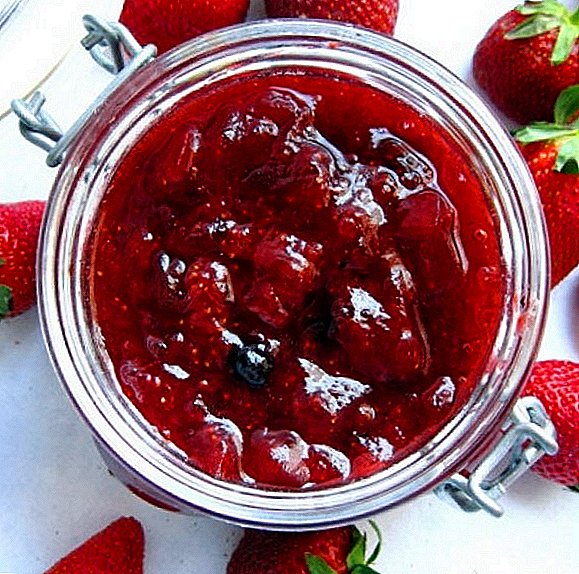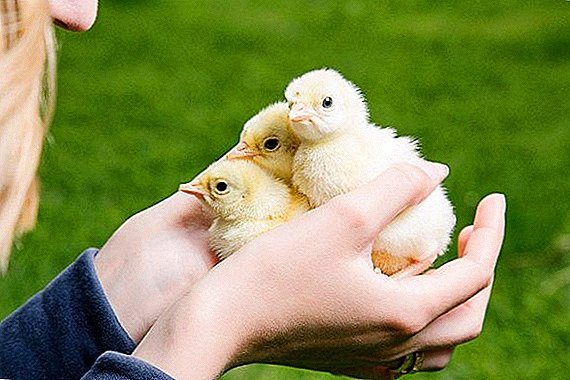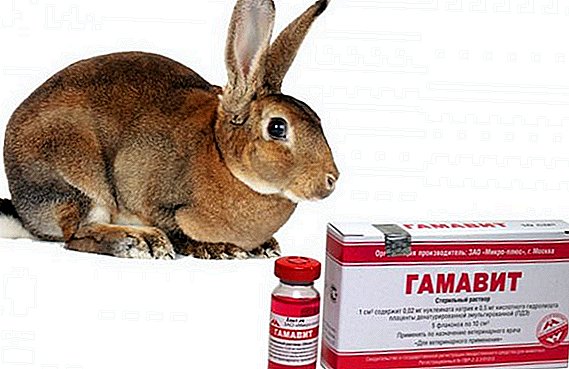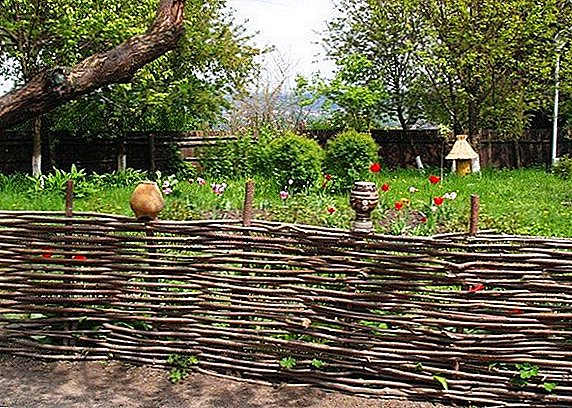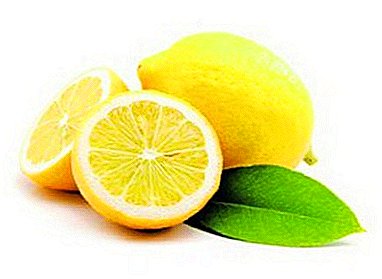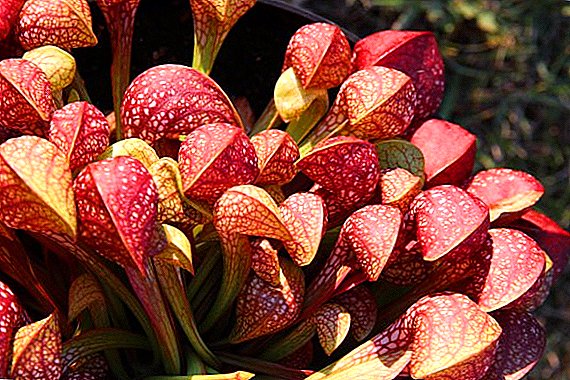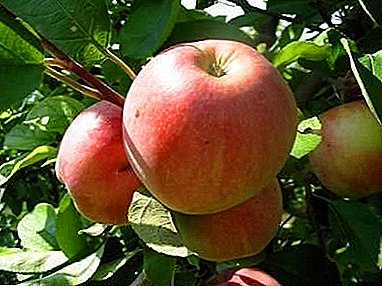
Apple trees are particularly attractive for gardeners, which have several advantages over other varieties in terms of resistance to adverse conditions, crop quality and organoleptic properties.
One of these valuable varieties is Malt Bagaevsky.
What kind is it?
Apple Tree Malt Bagaevsky belongs to the group of summer varieties apples.
Fruits do not have good lezhkost - less than a month, so it is recommended to use them for the first time after removal.
Pollination
The best varieties for pollination are Anis Striped, Rennet Peasgood, Bellefle-Kitayka, Papirovka, Antonovka.
Description variety Malt Bagaevsky
For a gardener it is very important to know how the tree grows.
 The trees of this variety grow tall and large, have a sweeping crown, the shape of which is flat-rounded.
The trees of this variety grow tall and large, have a sweeping crown, the shape of which is flat-rounded.
Tree branches thick, grow from the trunk at a large angle.
Tree bark gray, rough to the touch.
Shoots medium thickness, color - brown.
Leaves, mostly large in size, in shape - oval, slightly oblong, pointed to the top. In one inflorescence grows about six flowers.
Colour - creamy white, the shape of the flowers is cupped.
Fruit
Apples are usually average.
Weight reaches 120 g
The form - flat and round, the surface is smooth, ribbing is weak.
Traditional color - or white or green, upon reaching the maturation period becomes yellowish-green.
Third of apple surface, and sometimes completely, covered with a short striped blush.
On the skin A small wax deposit is visible in the fetus; there is a large number of white subcutaneous large spots.
Pulp structure dense, fine-grained, porcelain white color with a reddish tinge, crispy and juicy, the taste is sweet-sour, aromatic.
A photo
In the photo is the apple tree “Malt Bagaevsky”:



Breeding history
In the book Rytov M.V. this variety of apple is indicated as a variety of national selection.
In 1908 was found in the village Bagaevka (Saratov region), in the Kuznetsov garden, by VV Pashkevich, scientist-pomolog
Growing region
Homeland apple is considered the Saratov region.
Also, the main growing regions according to the state register are the regions of Central Russia, the Middle Volga region, and Mordovia.
Malt Bagaevsky is an apple tree with high resistance to arid regions, and also has frost-resistant qualities, therefore develops well in the southern territories.
However, the conditions of the Volgograd region are not sufficiently favorable for a rich yield.
Yield
The high yield of Malta Bagaevsky is one of its advantages.
 After planting, the tree begins to bear fruit in the sixth or seventh year.
After planting, the tree begins to bear fruit in the sixth or seventh year.
The periodicity of fruiting is smooth.
Productivity reaches five hundred centners per hectare, up to one hundred or more kilograms of fruit from one tree with full fruiting.
The abundance of yield can last from 80 to 150 years.
The period of picking up apples falls on the end of July and the first decade or mid-August, ready for consumption after a week.
Landing
For planting and caring for apple trees there is a general set of rules.
The most successful landing period is autumn, when the cold has not come yet, and spring, when the earth has not yet fully warmed up.
In the autumn
This period has its own advantages: for example, after the winter, the roots of an apple tree have enough time to strengthen and get settled.
 Landing is traditionally made in early October.
Landing is traditionally made in early October.
Begin training usually in a few months.
To do this, it is necessary to prepare the soil and pit for planting.
Favorable soil for the growth of Malta Bagaevsky should have a high salt content.
It should also be loose enough to have access to water and air.
The depth of the pit should be about 70 centimeters deep.
The upper layer, which is more fertile, should be discarded separately from the lower one.
Then in the center of the groove you need to install a peg so that above the ground there is about a third of a meter.
TIP: Burn the part of the peg that is underground - this will save it from rotting.
The next step is to prepare the mixture to completely fill the pit. The mixture is a top layer mixed with organic fertilizer, humus or peat.
We fill the pit so that a small mound is formed - this is necessary in order for the time before planting the soil to be enough to “sit down” and thicken.
Before planting the seedling in the mound, you need to make a small depression and fill it with a little black earth.
Plant a tree should be so that the peg was on the south side of the trunk.
The root neck of the seedling should show approximately 5 centimeters above ground level.
The tree is tied to a peg to prevent the fall of the apple tree.
Final stage - watering, on one apple tree - up to four buckets of water. Sprinkle with soil.
In the spring
Landing is made in late April.
The main feature of planting apple trees in the spring is abundant watering in order to avoid drying out the roots.
Plus, planting seedlings in the spring - resistance before hibernation. Pit for planting prepared in a week.
Pit for planting prepared in a week.
In high-quality and fertile soil, the recess should not exceed 60 centimeters, otherwise depth must be at least 70 centimeters. Diameter - about 80 centimeters.
Before planting, moisten the root system, leaving the tree in water for a day.
Next, landing is the same as in the fall.
Watering should be done until the soil is no longer absorb water. So that the moisture does not evaporate, the soil is covered with humus.
Care
The complex for caring for an apple tree includes pruning the tree, fertilizing the soil, processing the crown and treating wounds.
Pruning the branches of an apple tree should be done in early spring.
Deleting branches occurs in three stages:
- In adult trees (from seven years old), branches on the crown are removed, since they do not carry any benefit. Young trees have a better not to do this.
- Pruned branches that have been damaged, broken, dried, or undergone disease.
- Removed annual shoots.
ATTENTION: should be removed those branches that grow parallel to the trunk or towards it.
It is necessary to fertilize the soil after all the weeds have been removed.
Recommended fertilizers:
- ash (for one glass - a liter of water),
- one to ten manure diluted with water
- copper sulphate,
- bird droppings.
Solutions Strobi, Fury or copper oxychloride crown of wood treated in early spring.
One of the recipes: Wood resin must be reheated until it becomes liquid. Then, carefully mixing, it is added gradually turpentine. At the end add pork or mutton fat. Watering the apple trees is rare, but abundant.
Diseases and pests
This variety is resistant to black cancer and is moderately resistant to scab. What to do if this disease still overtook an apple tree?
 The causative agent of this unpleasant infection is on the leaves, so in the gardens, where scab infection was observed, the leaves must be cleaned and destroyed.
The causative agent of this unpleasant infection is on the leaves, so in the gardens, where scab infection was observed, the leaves must be cleaned and destroyed.
Processing should be done after harvest.
To do this, half a kilogram of urea is diluted with ten liters of water and sprayed with this substance to the crown of the tree.
And in the spring even more concentrated solution (700 grams) need to cultivate the soil around the trunk of an apple tree.
Apple is treated with two ampoules of "Skor", diluted in ten liters of water in early spring, as well as after flowering.
After that, the tree must again be immediately treated with either potassium salt or urea, 50 grams of which must be diluted in a bucket of water.
The variety Malt Bagaevsky has many advantages:
- it is resistant to drought and frost
- fruits have high taste
- abundant yield.
However, the shelf life of fruit is very low, and transportation is also very undesirable.


